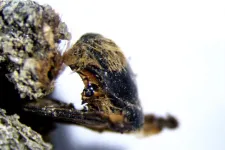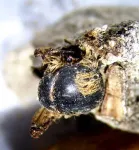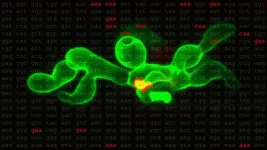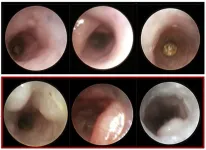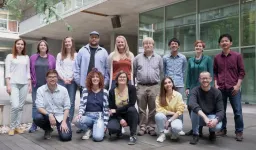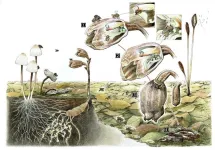(Press-News.org) A new study reports the discovery of hundreds of mummified bees inside their cocoons. These cocoons, produced almost three thousand years ago, were discovered in a new paleontological site discovered on the coast of Odemira, in Portugal.
About 2975 years ago, Pharaoh Siamun reigned in Lower Egypt; in China the Zhou Dynasty elapsed; Solomon was to succeed David on the throne of Israel; in the territory that is now Portugal, the tribes were heading towards the end of the Bronze Age. In particular, on the southwest coast of Portugal, where is now Odemira, something strange and rare had just happened: hundreds of bees died inside their cocoons and were preserved in the smallest anatomical detail.
The cocoons, now discovered, resulted from an extremely rare fossilization method – normally the skeleton of these insects is rapidly decomposed due to its chitinous composition, which is an organic compound.
“The degree of preservation of these bees is so exceptional that we were able to identify not only the anatomical details that determine the type of bee, but also its sex and even the supply of monofloral pollen left by the mother when she built the cocoon”, says Carlos Neto de Carvalho, scientific coordinator of Geopark Naturtejo, a UNESCO Global Geopark, and collaborating researcher at Instituto Dom Luiz, at the Faculty of Sciences of the University of Lisbon - Ciências ULisboa (Portugal).
The paleontologist says that the project that led to this discovery identified four paleontological sites with a high density of bee cocoon fossils, reaching thousands in a square measuring one meter on a side. These sites were found between Vila Nova de Milfontes and Odeceixe, on the coast of Odemira, a municipality that gave strong support to the execution of this scientific study, allowing its dating by carbon 14.
“With a fossil record of 100 million years of nests and hives attributed to the bee family, the truth is that the fossilization of its user is practically non-existent”, reinforces Andrea Baucon, one of the co-authors of the present work, paleontologist at the University of Siena (Italy).
The cocoons now discovered, produced almost three thousand years ago, preserve as in a sarcophagus the young adults of the Eucera bee that never got to see the light of day. This is one of about 700 species of bees that still exist in mainland Portugal today. The newly discovered paleontological site shows the interior of the cocoons coated with an intricate thread produced by the mother and composed of an organic polymer. Inside, you can sometimes find what's left of the monofloral pollen left by the mother, with which the larva would have fed in the first times of life. The use of microcomputed tomography allowed to have a perfect and three-dimensional image of the mummified bees inside sealed cocoons.
Bees have more than twenty thousand existing species worldwide and are important pollinators, whose populations have suffered a significant decrease due to human activities and which has been associated with climate change. Understanding the ecological reasons that led to the death and mummification of bee populations nearly three thousand years ago could help to understand and establish resilience strategies to climate change. In the case of the southwest coast, the climatic period that was experienced almost three thousand years ago was marked, in general, by colder and rainier winters than the current ones.
“A sharp decrease in the nocturnal temperature at the end of winter or a prolonged flooding of the area already outside the rainy season could have led to the death, by cold or asphyxiation, and mummification of hundreds of these small bees”, explains Carlos Neto de Carvalho.
This study is the result of an Ibero-Italian cooperation that brought together researchers from Instituto Dom Luiz – Ciências ULisboa, DISTAV – University of Genova (Italy), MARE – University of Coimbra (Portugal), the Polytechnic Institute of Tomar (Portugal), the Portuguese Centre of Geo-History and Prehistory, the Abdus Salam Research Center in Theoretical Physics, University of Siena (Italy), University of Venice (Italy) and University of Seville (Spain).
END
Bees from the time of the pharaohs found mummified on the Southwest Coast of Portugal
2023-08-24
ELSE PRESS RELEASES FROM THIS DATE:
Study IDs secret of stealthy invader essential to ruinous rice disease
2023-08-24
The virulence of a rice-wrecking fungus — and deployment of ninja-like proteins that help it escape detection by muffling an immune system’s alarm bells — relies on genetic decoding quirks that could prove central to stopping it, says research from the University of Nebraska–Lincoln.
A Nebraska team helmed by Richard Wilson hopes that identifying an essential but formerly unknown stage in the fungal takeover of rice cells can accelerate the treatment or prevention of rice blast disease, which ruins up to 30% of global yields each year.
“The response I’ve gotten from people in my field is that they’re very excited, ...
Mutations in blood stem cells can exacerbate colon cancer
2023-08-24
Researchers at the University of Florida College of Medicine have discovered how common age-related changes in the blood system can make certain colon cancers grow faster. The study, to be published August 24 in the Journal of Experimental Medicine (JEM), also suggests how these effects might be therapeutically targeted to reduce tumor growth and improve patient survival.
As we age, the hematopoietic stem cells that reside in the bone marrow and give rise to all of the body’s different blood cells gradually acquire mutations in their ...
The ‘treadmill conveyor belt’ ensuring proper cell division
2023-08-24
Researchers at the Centre for Genomic Regulation (CRG) have discovered how proteins work in tandem to regulate ‘treadmilling’, a mechanism used by the network of microtubules inside cells to ensure proper cell division. The findings are published today in the Journal of Cell Biology.
Microtubules are long tubes made of proteins that serve as infrastructure to connect different regions inside of a cell. Microtubules are also critical for cell division, where they are key components of the spindle, the structure which attaches itself to chromosomes and pulls them apart into each new cell.
For the spindle to function properly, cells rely on microtubules to ‘treadmill’. ...
Significant progress in cell separation technology made by Griffith University team
2023-08-24
Early detection allows for timely intervention in many diseases before they progress to a severe stage, often at a lower treatment cost. This is particularly crucial in the case of cancer, as the stage of cancer development at the time of initial diagnosis significantly influences the patient's prognosis and survival rate. Therefore, regular medical check-ups can ensure better survival and quality of life. However, the multitude of medical examination items makes the experience both loved and loathed. With various ...
Fungi-eating plants and flies team up for reproduction
2023-08-24
Fungi-eating orchids were found for the first time to offer their flowers to fungi-eating fruit flies in exchange for pollination, which is the first evidence for nursery pollination in orchids. This unique new plant-animal relationship hints at an evolutionary transition towards mutualistic symbiosis.
Orchids are well known to trick their pollinators into visiting the flowers by imitating food sources, breeding grounds or even mates without actually offering anything in return. The fungi-eating, non-photosynthetic orchid genus Gastrodia is no different: To attract fruit flies (Drosophila spp.), the plants usually emits a smell like their common diet of fermented fruits ...
Preterm babies given certain fatty acids have better vision
2023-08-24
Preterm babies given a supplement with a combination of omega-3 and omega-6 fatty acids have better visual function by the age of two and a half. This has been shown by a study at the University of Gothenburg, Sweden.
The study, published in The Lancet Regional Health Europe, covers 178 extremely preterm babies at the neonatal units of the university hospitals in Gothenburg, Lund, and Stockholm between 2016 and 2019. Extremely preterm babies are those born before the 28th week of pregnancy.
Around half of the children were given preventive oral nutritional supplements containing the omega-6 fatty acid AA (arachidonic acid) and the omega-3 fatty acid DHA (docosahexaenoic ...
Manchester research to boost bioprinting technology to address critical health challenges in space
2023-08-24
New research by The University of Manchester will enhance the power of bioprinting technology, opening doors to transform advances in medicine and addressing critical health challenges faced by astronauts during space missions.
Bioprinting involves using specialised 3D printers to print living cells creating new skin, bone, tissue or organs for transplantation.
The technique has the potential to revolutionise medicine, and specifically in the realm of space travel, bioprinting could have a significant impact.
Astronauts on extended space missions have ...
Social media does not cause depression in children and young people
2023-08-24
“The prevalence of anxiety and depression has increased. As has the use of social media. Many people therefore believe that there has to be a correlation,” says Silje Steinsbekk, a professor at the Norwegian University of Science and Technology's (NTNU) Department of Psychology.
But that is not the case if we are to believe the results of the study “Social media behaviours and symptoms of anxiety and depression. A four-wave cohort study from age 10-16 years”.
Trondheim Early Secure Study
In the Trondheim Early Secure Study research project, researchers followed 800 children in Trondheim ...
Researchers reveal electronic nematicity without charge density waves in titanium-based kagome metal
2023-08-24
Chestnut Hill, Mass (8/24/2023) – Electronic nematic order in kagome materials has thus far been entangled with charge density waves. Now it is finally observed as a stand-alone phase in a titanium-based Kagome metal, a team of researchers led by Boston College physicists reported recently in Nature Physics.
Quantum materials composed of atoms arranged on a kagome net of corner-sharing triangles present an exciting platform to realize novel electronic behavior, paper co-author and Boston College Professor of Physics Ilija Zeljkovic explained.
There ...
Mount Sinai researchers find Asian Americans to have significantly higher exposure to “toxic forever” chemicals
2023-08-24
New York, NY (August 24, 2023) — Asian Americans have significantly higher exposure than other ethnic or racial groups to PFAS, a family of thousands of synthetic chemicals also known as “toxic forever” chemicals, Mount Sinai-led researchers report.
People frequently encounter PFAS (per- and polyfluoroalkyl substances) in everyday life, and these exposures carry potentially adverse health impacts, according to the study published in Environmental Science and Technology, in the special issue “Data Science for Advancing Environmental Science, Engineering, and Technology.”
The ...
